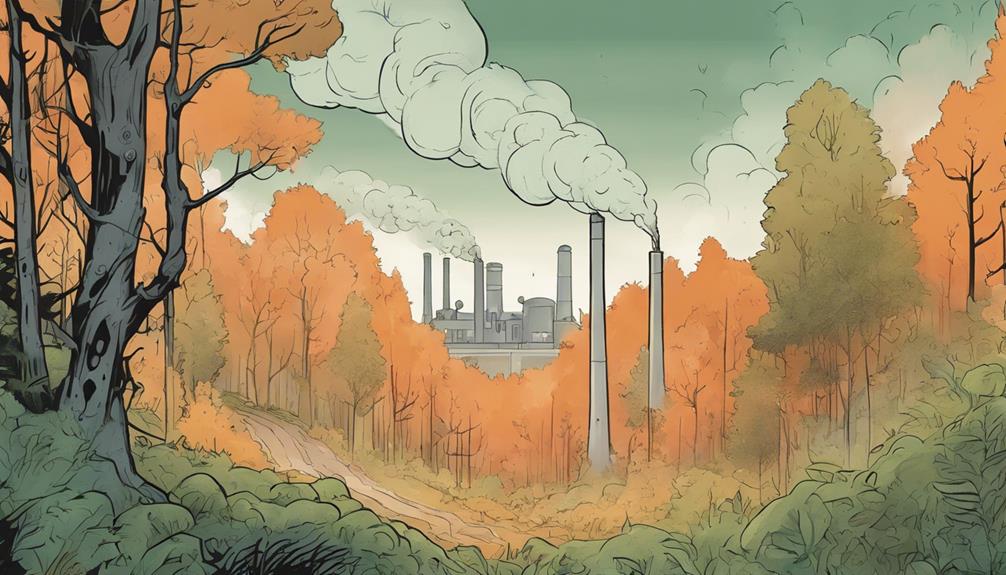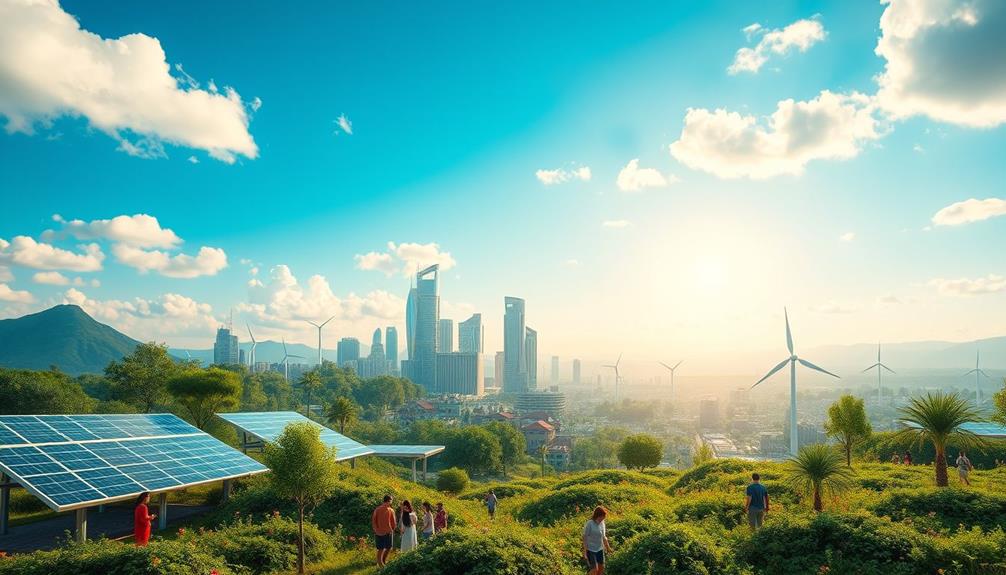As we tap into Earth's inner heat source, we're accessing a vast, renewable energy reservoir that's been hiding in plain sight. Driven by radioactive decay in the core, geothermal power has the potential to generate up to 10% of the world's electricity by 2050. By harnessing this energy, we can reduce our reliance on fossil fuels and mitigate climate change. But to get there, we need to overcome exploration challenges, improve efficiency, and address environmental concerns. Let's dive deeper into the inner workings of geothermal power and uncover the secrets to accessing its full potential.
Key Takeaways
- Earth's core generates immense heat energy through radioactive decay, creating an underground thermal energy reservoir.
- Geothermal power harnesses this energy by drilling into reservoirs, accessing high-temperature areas, and managing resources for electricity generation.
- Accurate data on subsurface conditions is crucial for successful geothermal exploration, but challenges like risks and limited data availability persist.
- Geothermal energy's environmental impact is relatively low, emitting only 5% of CO2 produced by coal-fired plants, and can be further mitigated through responsible management.
- Innovative technologies, collaborations, and investments are unlocking geothermal potential, paving the way for a geothermal revolution.
Earth's Natural Heating System

As we explore into the world of geothermal power, we find that the Earth's natural heating system is driven by the radioactive decay of isotopes in its core, which releases an immense amount of heat energy.
This heat is then transferred to the surrounding rocks and fluids, creating a vast, underground reservoir of thermal energy. The movement of tectonic plates allows this heat to escape, forming hot springs, geysers, and volcanoes.
These natural wonders not only provide a glimpse into the Earth's internal dynamics but also offer a promising source of renewable energy. By tapping into this heat, we can generate electricity, providing a clean and sustainable alternative to fossil fuels.
Harnessing Geothermal Power

We tap into the Earth's internal heat by drilling into underground reservoirs, accessing the potential to generate electricity from this renewable energy source. This process involves drilling techniques like directional drilling to reach high-temperature areas.
Once we've accessed the geothermal resource, we manage the reservoir to maximize energy production. Proper maintenance of power plant infrastructure is critical to ensure sustainability. Environmental practices are also essential to guarantee long-term viability.
Overcoming Exploration Challenges

Frequently, accurate data on subsurface conditions proves hard to find, hindering geothermal exploration and requiring innovative approaches to overcome these challenges.
We face risks associated with drilling and specialized equipment, which can be expensive and time-consuming.
Additionally, site assessment for geothermal energy often faces limitations in data availability, making it difficult to identify high-potential areas.
To overcome these exploration challenges, we need technical expertise and significant resources.
Ensuring safe and efficient drilling practices is crucial for geothermal projects.
We must develop new technologies and strategies to improve our understanding of subsurface conditions, reduce risks, and increase the success rate of geothermal exploration.
Efficiency and Environmental Impact

Geothermal energy's cost and efficiency vary greatly based on location and technology, making it important to assess and mitigate its environmental impact.
As we explore the efficiency of geothermal energy, we find that it's essential to address potential environmental concerns. Proper reservoir management is key to minimizing these impacts.
We've learned that geothermal energy emits only 5% of the carbon dioxide produced by coal-fired power plants, making it a relatively clean source of energy. However, we must still consider strategies to mitigate high upfront costs, such as technological advancements and alternative financing options.
Mitigating Environmental Concerns

Striking a balance between harnessing the Earth's inner heat and preserving its natural integrity is essential, as the environmental implications of geothermal energy production can be far-reaching if not properly managed.
We must prioritize responsible reservoir management to minimize the risk of induced seismicity, land subsidence, and water pollution. Implementing effective monitoring systems and transparent reporting practices helps identify potential issues early on, enabling swift corrective action.
Additionally, adopting closed-loop systems and injecting wastewater back into the reservoir reduces the environmental footprint of geothermal operations. By taking proactive steps to mitigate environmental concerns, we can ensure that geothermal power remains a sustainable and responsible contributor to the global energy mix.
Regulatory and Technological Hurdles

As we work to harness the full capacity of geothermal energy, we must navigate a complex web of regulatory and technological hurdles that can slow project development and increase costs.
One major challenge is the lack of standardization in permitting requirements, which can lead to lengthy and cumbersome application processes. We need to develop online platforms for streamlined permit submission and review, and increase collaboration between agencies for efficient project approvals.
Additionally, technological advancements are essential to overcome efficiency limitations. For instance, heat exchanger design and fluid management systems can greatly impact environmental protection.
Unlocking Geothermal Potential

We're on the cusp of a geothermal revolution, with innovative technologies and strategic collaborations poised to reveal the vast, untapped potential of this renewable energy source.
As we explore new methods to harness the Earth's inner heat, we're finding ways to make geothermal energy more accessible and affordable. Advanced drilling techniques, like directional drilling, are allowing us to tap into previously inaccessible resources.
Meanwhile, improved reservoir management and enhanced geothermal systems (EGS) are increasing the efficiency of existing operations. By combining these innovations with strategic partnerships and investments, we're opening the door to a geothermal future that could fulfill 10% of the world's electricity needs by 2050.
Frequently Asked Questions
Can Geothermal Energy Be Used for Heating and Cooling Buildings?
We can harness geothermal energy for heating and cooling buildings, leveraging the Earth's natural heat to provide a sustainable and efficient alternative to traditional HVAC systems, reducing our carbon footprint.
How Does Geothermal Energy Compare to Other Renewable Energy Sources?
We're curious about how geothermal energy stacks up against other renewables. Compared to solar and wind, geothermal energy offers a reliable, constant source of power, making it an attractive option for baseload electricity generation.
Are Geothermal Power Plants Suitable for Urban Areas?
We've learned that geothermal energy could fulfill 10% of the world's electricity needs by 2050 While it's possible to build geothermal power plants near urban areas, we need to take into account noise, land use, and potential environmental concerns.
Can Geothermal Energy Be Stored for Later Use?
We're exploring if geothermal energy can be stored for later use. While it's challenging, thermal energy storage systems can store heat for short periods, but scaling up for long-term storage remains a significant technological hurdle.
What Is the Average Lifespan of a Geothermal Power Plant?
We're discussing the average lifespan of a geothermal power plant, which typically ranges from 25 to 30 years, depending on factors like reservoir quality, maintenance, and operational efficiency.
What Can We Learn from the Philippines’ Geothermal Energy Resources about Earth’s Inner Heat Source?
The Philippines’ geothermal energy potential provides valuable insights into the Earth’s inner heat source. By harnessing this natural energy, we can learn about the abundance of geothermal resources beneath the Earth’s surface and the potential for sustainable power generation. Understanding geothermal energy helps us tap into the planet’s renewable energy sources.
Conclusion
As we wrap up our journey to the Earth's inner heat source, we're left wondering why we're still stuck on fossil fuels. I mean, who needs climate change and pollution when we've got a planet-sized furnace beneath our feet?
It's a no-brainer, really. Let's ditch the dinosaurs (fossil fuels, that is) and harness the heat. Our planet – and our grandkids – will thank us.
Now, if you'll excuse us, we've got some geothermal energy to tap into.









